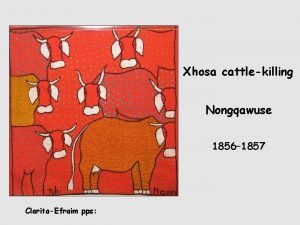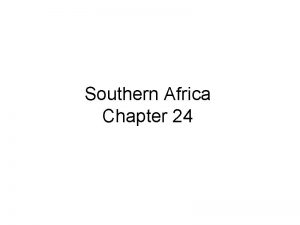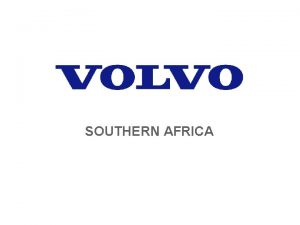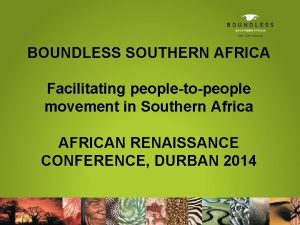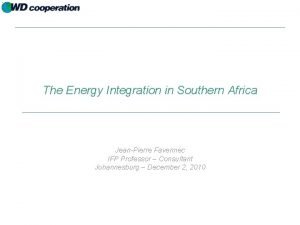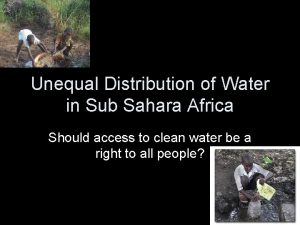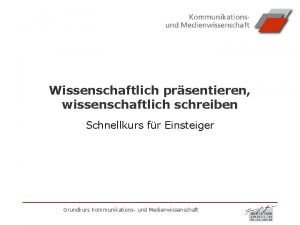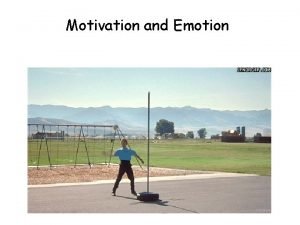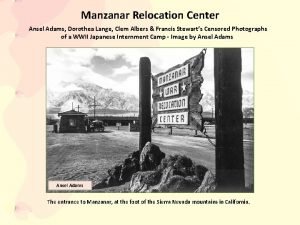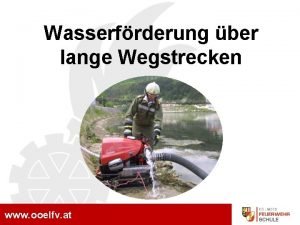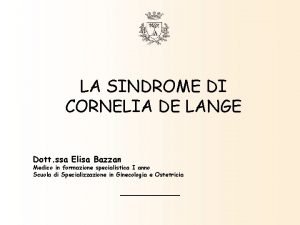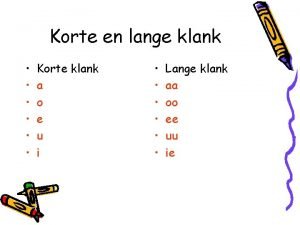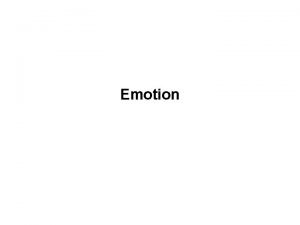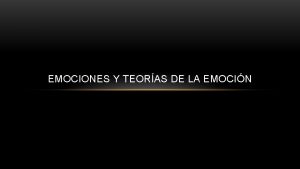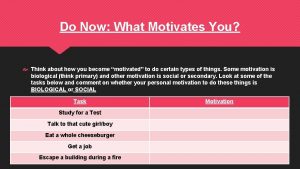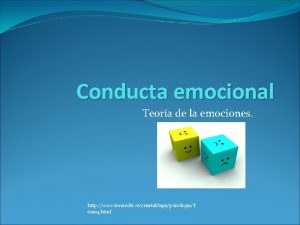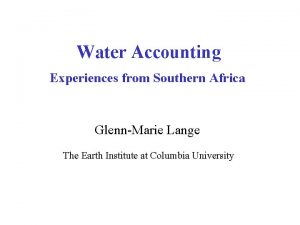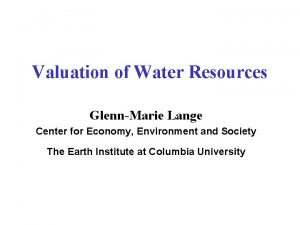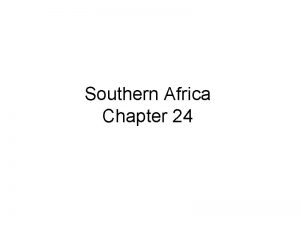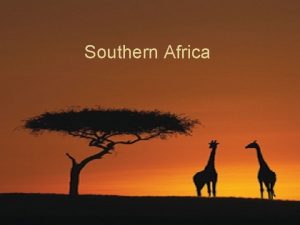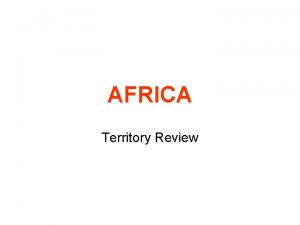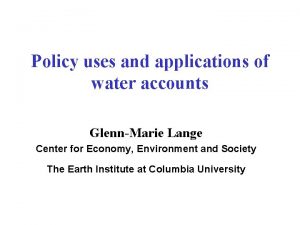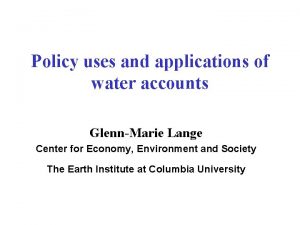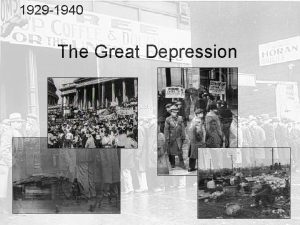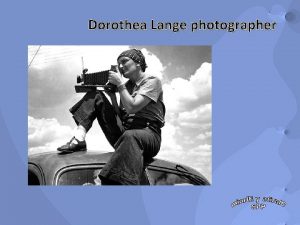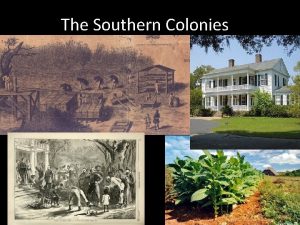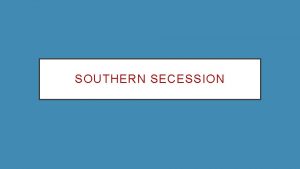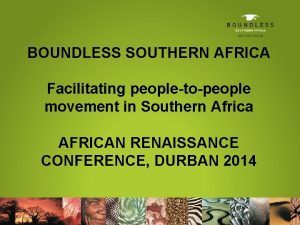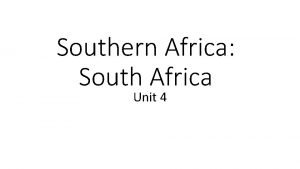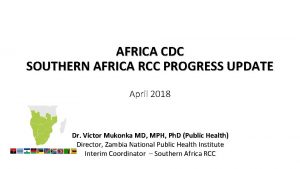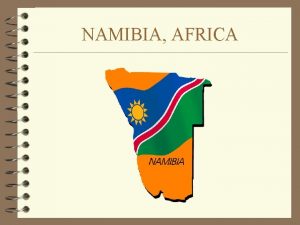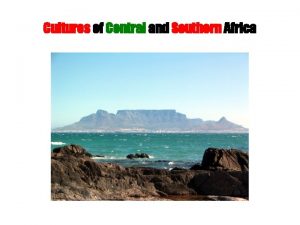Water Accounting Experiences from Southern Africa GlennMarie Lange
































- Slides: 32

Water Accounting Experiences from Southern Africa Glenn-Marie Lange The Earth Institute at Columbia University

Natural Resource Accounting Programme in East & Southern Africa Started in 1995, currently in Phase 3 Includes • Botswana, Namibia, South Africa • More recently, Mozambique, Tanzania, Uganda Secretariat at the University of Pretoria, South Africa

Natural Resource Accounting Programme in East & Southern Africa Minerals Water Fisheries Botswana X X Namibia X X South Africa X X Tanzania X X X Regional case study Mozambique Uganda X Forests partial X X Land/Land degradation partial

WATER: Critical Resource in Botswana, Namibia, South Africa ALL COUNTRIES CHARACTERIZED BY: • Low, highly variable rainfall (250 -500 mm/year), high evapotranspiration • High reliance on fossil groundwater (Botswana and Namibia) • No perennial rivers entirely within a country • Growing reliance on shared international rivers Regional water commissions negotiate allocations of water from int’l rivers • Water supply vulnerable to climate change • Water is highly subsidized NEED TO MONITOR AND MANAGE WATER IN SOUTHERN AFRICA

What Do Policy-Makers Need from Water Accounts? Economic information to make decisions: 1. Allocation of water, water infrastructure among competing users: • • • 2. Economic users: agriculture-hydroelectric-municipal, etc. Ecological requirements: biodiversity-mining-tourism Meeting international requirements Water pricing and economic instruments: • • Understand variation of water costs/treatment by region and set prices accordingly Understand impact of water tariffs on different industries and different social groups, especially the poor 3. Coordinating policy in related sectors: agriculture, rural development, tourism, etc. 4. Planning for future water requirements, water conservation & demand management

Water Accounts in Botswana, Namibia and South Africa Years covered: – Botswana: 1993 -2001 – Namibia: 1993 & 1996, 1997 -2000 – South Africa: 1998 and 2000 Water classified by natural source & institution that supplies water Water end-users classified by – ISIC: Botswana and Namibia – Dept of Water Affairs classification: South Africa— THIS IS A PROBLEM—colleagues at Univ. of Pretoria have partially adjusted the official water accounts Geographic coverage – National water accounts: Botswana, Namibia, South Africa – Catchment-level accounts: South Africa, partial in Namibia, possible in Botswana

Water Classifications: Natural Source and Supplying Institution CLASSIFICATION OF NATURAL SOURCES CLASSIFICATION OF SUPPLYING INSTITUTIONS BOTSWANA Groundwater Dam storage of seasonal rivers Perennial surface water Water Utilities Corporation Dept. of Water Affairs District Councils Self-providers NAMIBIA Groundwater Dam storage of seasonal rivers Perennial surface water Recycled wastewater Seawater Namwater Municipal authorities Rural Water Supply Rural communities Self-providers: Agriculture, Mining SOUTH AFRICA Groundwater Surface water Soil water Dept. of Water Affairs and Forestry Irrigation Boards Water Boards Municipalities

Classification of End-Users (number of industries in each country’s water accounts) Botswana Namibia South Africa Agriculture 2 5 4 Mining 4 2 2 Manufacturing & utilities 5 10 4 Aggregated from 8 Aggregated from 20 Services 7 7 2 Government 2 1 1 Households 2 22 27 14 partial yes No (urban-rural) Total end-users in water use accounts Losses

Data Sources for Water Use: Metered Water Use or Estimated Use? Botswana Namibia South Africa Administrative records that meter individual users 49% 38% By estimation 0% 100% (mainly agriculture) 51% 63%

SEEAW Chapter 9. B Indicators and statistics B. 1 Source of pressure on water resources: • • • Macro trends in total water use, emissions, water use by natural source and purpose, etc. Industry-level trends Technology and driving forces B. 2 Potential for increasing effective supply and improving water productivity • Reducing system losses B. 3 Water pricing and incentives for water conservation B. 4 Sustainability: comparing water resources and water use

Botswana, 1992 = 1. 00 NATIONAL TRENDS: Decoupling of Growth & Water Use? Namibia: 1993 = 1. 00 Index of water use & productivity

Water supply by natural source in Namibia, 2001/02 Total water supply: 395 Mm 3 Total freshwater: 326 Mm 3 Some groundwater from fossil sources. Nationally small, <5% of water use. Locally, 100% with few alternatives.

Supply of Freshwater by Supplying Institution Note: rural communities not recorded as supplying own water

Industry-level trends: Freshwater use by source and end-user in Namibia, 2001/02 (million cubic meters)

INDUSTRY-LEVEL TRENDS: ENVIRONMENTAL ECONOMIC PROFILE Distribution of water use, GDP & employment by industry in Namibia, 2001

Water Productivity by Industry in Namibia, 1997 & 2000: GDP per m 3 water use (constant 1995 prices)

Understanding Driving Forces What drives water demand? Final use by households + total water needed to produce goods for Final Demand: – Household consumption – Government expenditures – Investment – Exports Total water requirements include direct + ‘upstream’ water, that is, the water used to produce all the inputs to production. calculated using Input-Output model

Direct and Total Water Requirements by Industry: Namibia, 2001/02

Losses & Unaccounted for Water in Namibia, 2000

Average cost of supply by Institution and source of water in Namibia, 2000

Water Subsidies by Nam. Water, the bulk water supplier (provides 40% of all water; Tariffs – Supply Costs) Tariff-Supply Cost Water Productivity $/m 3 water use $VA/m 3 water Crop irrigation -3. 04 0. 99 Livestock 0. 02 20. 86 Mining 0. 00 52. 72 Manufacturing 0. 99 226. 56 Construction -2. 21 1774. 40 Services -2. 40 575. 31 Government -0. 66 234. 19 Sales to other water suppliers 0. 68 NA

CROSS COUNTRY COMPARISONS: Water productivity in Botswana, Namibia, and South Africa, 2000 (rands of value-added per cubic meter of water used) National Level By Industry Botswana Namibia South Africa Agriculture 14 7 3 Mining 513 389 142 Manufacturing 1000 455 215 Services 2962 1113 606 Government 553 338 876

Water subsidies in Botswana, Namibia and South Africa, 2000

Water management & policy analysis Trade & the environment Managing an international river basin

International Trade & Water Use Are water-scarce countries exporting water? How much can imports reduce pressure on water demand? • ‘Virtual Water’ is the water embodied in imported goods • countries can meet some of their water needs by importing water-intensive goods rather than producing the goods themselves Net balance of trade in ‘virtual water’ determined by • Volume of imports compared to exports • Total water intensity of imports compared to exports

International Trade & Water Use How much does Int’l Trade drive water demand in Namibia, Botswana and South Africa? Export promotion is a major part of national economic development strategy Exports are dependent on primary & processed primary commodities 76% Botswana: mostly mining 79% Namibia: agriculture, mining, fisheries 47% South Africa: agriculture, forestry, mining Primary products, especially agriculture and processed agricultural products can be water intensive

Method of Analysis Use Input-Output analysis to calculate direct and total water requirements for exports & imports Exports are no problem, use countries’ water accounts Problem: what is the water content of imports from another country? Botswana & Namibia get most of their imports from South Africa, so we use South Africa’s water accounts & the results are accurate But South Africa imports mainly from other countries…so – Assume other countries have same water intensity as South Africa – Use South Africa’s water accounts THIS ASSUMPTION IS WIDELY USED IN ALL COUNTRIES We can only calculate trade in water accurately when ALL countries have water accounts

International Trade & Water Use Are water-scarce countries exporting water? Net imports of water in Botswana, Namibia, South Africa in 1998

Why is South Africa a net exporter of water? Its volume of exports is slightly > imports, but mainly because water intensity of exports > imports Water intensity of trade summed up over products (m 3 per 1000 rands of imports or exports)

RIVER BASIN ACCOUNTS Orange River: How should water be shared by the 4 riparian countries? Lesotho South Africa Botswana Namibia

Supply & use of water by riparian states in the Orange River Basin

Water productivity among riparian states in the Orange River Basin (rands GDP/m 3 of water used)
 Water and water and water water
Water and water and water water Nongqawuse prophecy
Nongqawuse prophecy Chapter 24 southern africa
Chapter 24 southern africa Volvo group southern africa
Volvo group southern africa Boundless southern africa
Boundless southern africa Southern african transport conference
Southern african transport conference Chartered secretaries southern africa
Chartered secretaries southern africa Southern africa
Southern africa How much water does africa have
How much water does africa have Zitate hausarbeit
Zitate hausarbeit Oktaaf se getal reels
Oktaaf se getal reels James lange
James lange Dorethea lange
Dorethea lange Which of the following best describes task performance?
Which of the following best describes task performance? Teoria de james lange
Teoria de james lange James lange vs cannon bard vs schachter singer
James lange vs cannon bard vs schachter singer We feel sorry because we cry represents the theory of
We feel sorry because we cry represents the theory of Aafke honkoop
Aafke honkoop Clem lange
Clem lange Wasserförderung über lange wegstrecken
Wasserförderung über lange wegstrecken Disgusting food
Disgusting food Sindrome di cornelia de lange
Sindrome di cornelia de lange Korte klank woorden
Korte klank woorden Klopapier thron
Klopapier thron Biometrische datenerfassung
Biometrische datenerfassung Regler for sammensatte ord
Regler for sammensatte ord Schachter's two factor theory
Schachter's two factor theory Motivation psychology
Motivation psychology Teoria de james lange
Teoria de james lange Facial feedback hypothesis
Facial feedback hypothesis Wie lange dauerte der hundertjährige krieg
Wie lange dauerte der hundertjährige krieg Teoria de james lange
Teoria de james lange James lange theory of emotion vs cannon bard
James lange theory of emotion vs cannon bard

